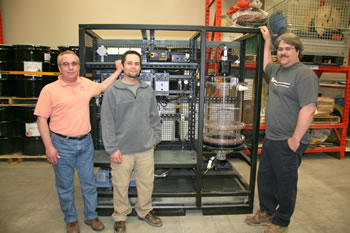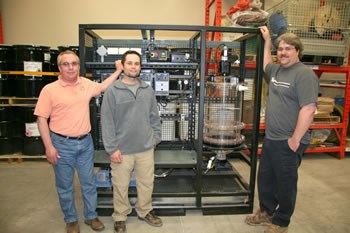
A tailings treatment technology developed in Sudbury is one of several solutions the Alberta oilsands industry is considering as an environmentally friendly alternative to underwater disposal in tailings ponds that are a blight on the province's landscape and reputation.Golder Paste Technology Ltd. (PasteTec), a Sudbury-based subsidiary of Golder Associates, has been pitching its technology to the major players in the Alberta oilsands sector for more than a year to help them comply with a recent Alberta Energy Resources Conservation Board Directive governing tailings disposal.PasteTec's Sudbury lab recently received a shipment of 36 drums of oilsands tailings for processing through a new mini pilot plant. The selection of the company's technology would be a major coup.Paste technology was pioneered at Inco in the early '90s as an alternative to hydraulic backfill."Prior to the introduction of paste for backfilling purposes or surface disposal, underground backfill was predominantly hydraulic fill," said Bruno Mandl, a senior project engineer with PasteTec. "Hydraulic fill was produced by separating out the coarse material from the fine material, or slime. The coarse material was augmented with cement and sent underground."The problem with hydraulic fill is that large quantities of water are also sent underground. That means the backfilling process has to be stopped at certain points in time in order to allow the water to decant."Paste backfill contains very little water, so there's no need to stop and start.
Paste technology is also commonly used for surface disposal of tailings as an alternative to conventional sub-aqueous disposal, which employs large quantities of water and has a very large footprint, as is the case in the oilsands.
The use of paste technology for surface disposal is ideal in areas such as the Peruvian Andes and Chile's Atacama Desert, where there is a deficiency of water, said Mandl.
"In order for them to obtain water, they have to pump it up from the coast to very high elevations. If you were to use conventionally discharged tailings, you'd be throwing a lot of water away as a result of evaporation."
Using PasteTec's process, the water is removed from the tailings in a paste plant and recirculated.
Toothpaste
The PasteTec end product has the consistency of toothpaste, takes up much less space and dries quickly, allowing much faster reclamation of the tailings disposal sites.The Alberta Energy Resources Conservation Board directive, released in February 2009, requires the reduction of fluid tailings, their capture in board-approved disposal areas and their conversion to "trafficable deposits," meaning they have to be able to bear the weight of heavy equipment.
PasteTec has designed and built paste plants for mining companies in North and South America, Europe and Australia, but has yet to apply the technology to oilsands operations.
"The technology is applicable, but it's a different industry and it's new to them, so there's the hurdle of convincing them that it will work," said Ryan Francoeur, PasteTec's lab manager.
Oilsands tailings have been making headlines across the country and around the world since April 2008, when 1,600 migratory ducks died in a Syncrude Canada Ltd. tailings pond north of Fort McMurray. The tailings pond was supposed to have noise-making cannons in place to scare away the birds, but wintry conditions delayed their deployment.
The incident has given the industry a black eye and is being used by environmental groups to persuade U.S. companies to boycott fuels derived from the oilsands.
According to the Rainforest Action Network, Canadian oilsands operators have already produced six billion tonnes of tailings - "enough to fill a canal 10 metres wide and 10 metres deep all across the 49th parallel from the Atlantic Ocean to the Pacific."
While critical of the industry, Alberta Premier Ed Stelmach downplayed the impact of the oilsands on migratory birds, noting that 30,000 birds are killed by wind turbines every year.
The case against Syncrude is currently in Alberta Provincial Court and continuing to make headlines.
Customization
Paste plants are customized to handle the tailings from the customer's site."We run the material through a series of tests to determine what its basic properties are," said Francoeur. "We look at mineralogy, chemistry, particle size distribution and specific gravity to compare it to the material we've handled in the past. Then we'll run it through a series of dewatering tests. We'll do some settling tests, try different flocculants and different dewatering and thickening technologies."
The resulting paste has to be the right consistency, he said.
"There's a fine line between something that will flow and something that's too thick to flow, so the challenge we have is producing a quality product that will stay within the upper and lower limits to make sure it's flowable."
The disposal of paste on surface is more expensive than current tailings disposal methods in the oilsands, but if it can keep ducks safe from harm and repair the reputation of the industry, it's probably money well spent.
In the mining industry, the higher price of paste technology - both for surface disposal as well as backfill - is offset by savings and reduced exposure to liability. As an example, Francoeur cited the 1998 failure of a conventional tailings dam at Boliden's Los Frailes lead-zinc mine in Spain that resulted in the release of four to five million cubic metres of acidic tailings into the environment.
With surface disposal of paste, there are no dams be to be concerned about and, according to Francoeur, the thickened tailings keep oxygen from reacting with the acid generating material, eliminating the need for sub-aqueous disposal.
"By leaving the fines in there, you reduce the permeability, so it's almost like a clay," he said.
"The use of paste backfill is also more expensive than hydraulic fill, but you have to consider the many advantages associated with reduced dilution," said Francoeur.
The failure of hydraulic fill adjacent to an area being mined results in the backfill reporting to the ore stream and being reprocessed through the mill.
Savings on binder
Another benefit of paste is the reduced costs for binder, said Mandl."The most expensive single input into underground backfill is the binder, or cement. Hydraulic fill contains 10 per cent binder, but paste requires only three to five per cent."
When the water in hydraulic fill decants, explained Mandl, it also "decants away binder that you're paying a lot of money for." The water and cement create a mess, clog sumps and require the consumption of energy to pump the water to surface.
Paste technology is used by mines in Red Lake, Timmins, Sudbury and Kirkland Lake.
Paste is also used at a thermal coal operation in Montana to dispose of fly ash and is proposed as a solution for potash and phosphate mine tailings.
The global headquarters for PasteTec has remained in Sudbury, said Mandl, because two of the largest mining companies in North America are located here and because of the city's mining expertise."
The Golder subsidiary has 45 employees in Sudbury and also operates smaller satellite offices in London and Calgary.



